**UPDATE** On December 15, 2021, the Brazilian Ministry of Agriculture canceled the project that had been awarded to PxD by public tender. We continue to work with our regional partners, IICA, and the Government of Brazil to identify complementarities and further opportunities for collaboration.
Claudia Carbajal Morelos, PxD’s Regional Manager for Latin America, lays out the contours of the project.
We are humbled and thrilled to have been announced as the winners of a tendering process to deliver digital extension services to 100,000 farmers in Brazil’s Northeast Region (NER). The announcement by Brazil’s Ministry of Agriculture, Livestock, and Food Supply (MAPA) on the 6th of July marked the conclusion of a rigorous and competitive five-month-long tendering process.
This was PxD’s first experience navigating a government tender process and will be our first project in Brazil!
Serving 100, 000 farmer users!
Our ambition is to send the first message by mid-January 2022. We will serve 30,000 farmer users in the first year, rising to 100,000 in the second. Our digital extension service will include advisory information on both livestock and crops.
Northeast Region (NER)
Brazil’s NER represents 18 percent of Brazil’s territory and is comprised of nine states: Maranhão, Piauí, Ceará, Rio Grande do Norte, Paraíba, Pernambuco, Alagoas, Sergipe and Bahia. Livestock husbandry is an important component of farming activity – the region is home to over 90 percent of the national goat herd, over 60 percent of Brazil’s sheep herd, and 13 percent of the country’s cattle and swine herds, respectively.
The region was home to 53.6 million people in the 2012 census. While this figure is equivalent to 28 percent of the national population, the Brazilian Institute of Geography and Statistics (IBGE), assessed the NER as the poorest region in the country and home to nearly half (47.9%) of Brazil’s population living under the poverty line (2018). The share of poverty is substantially lower in the Central-West and South regions, which account for 5.7 and 2.5 percent of Brazil’s population living in poverty.
While national poverty rates decreased in 2020 – primarily a result of public emergency aid and cash transfer programs extended in response to the economic impacts of the COVID-19 pandemic – the number of people living in poverty is expected to rise dramatically in 2021 following the scaling back of temporary assistance measures, poor labor market recovery, and a resurgent COVID-19 case count.
Widespread poverty in NER is complicated by frequent droughts that disproportionately impact rural and farming livelihoods.
Timeline
The project will run for 22 months. I am excited to activate our in-country team and we are already moving! We have already commenced the scoping component of the project to map the sector and improve our understanding of the region and its challenges.
Partnerships
The project will be implemented in partnership with the Government of Brazil’s Ministry of Agriculture, Livestock, and Food Supply (MAPA) and our regional partners, the Inter-American Institute for Cooperation on Agriculture (IICA). The project is being implemented as a Build Operate and Transfer initiative, whereby, at the end of the project’s implementation horizon, we will transfer management and operational responsibilities to our partners at MAPA.
Tarun Pokiya, Lead Agronomist, Prasanna Kumar, Senior Software Engineer, Hannah Timmis, India Research Manager, Tushar Singh, Research and Operations Associate, Srinivas VT, Senior Associate, and Revati Vaidya, Process and Product Innovation Associate, collaborated on this blog post to illustrate how a synthesis of workstreams – across agronomy, technology, research, and operations teams – inform our Ama Krushi Kharif digital advisory campaign.
From the foothills of the Himalayas in the west to Vietnam in the east, hundreds of millions of farmers’ eyes turn each June to the sky in anticipation of the monsoon. The coming of the rains marks the commencement of the Kharif planting cycle, the region’s primary growing season.
The quality of the monsoon season impacts the livelihoods of hundreds of millions of farming households, and – by extension – the caloric intake of billions of people. Kharif is disproportionately important for poor, smallholder farmers – the primary users of PxD’s services. Kharif is the season for growing rice – a critical staple and subsistence crop – and the rains benefit the land indiscriminately, whether you have resources to fund irrigation equipment and infrastructure, or not. But relying on the heavens to provide is risky: the monsoon is notoriously fickle, and unpredictable – the rains may come early, or late and progress consistently or haphazardly; climate change is shifting weather patterns and escalating the frequency and intensity of extreme weather events; and, as ever, pests and diseases lurk with unpredictable triggers.
Overview of PxD Initiatives in India – Q1 2021
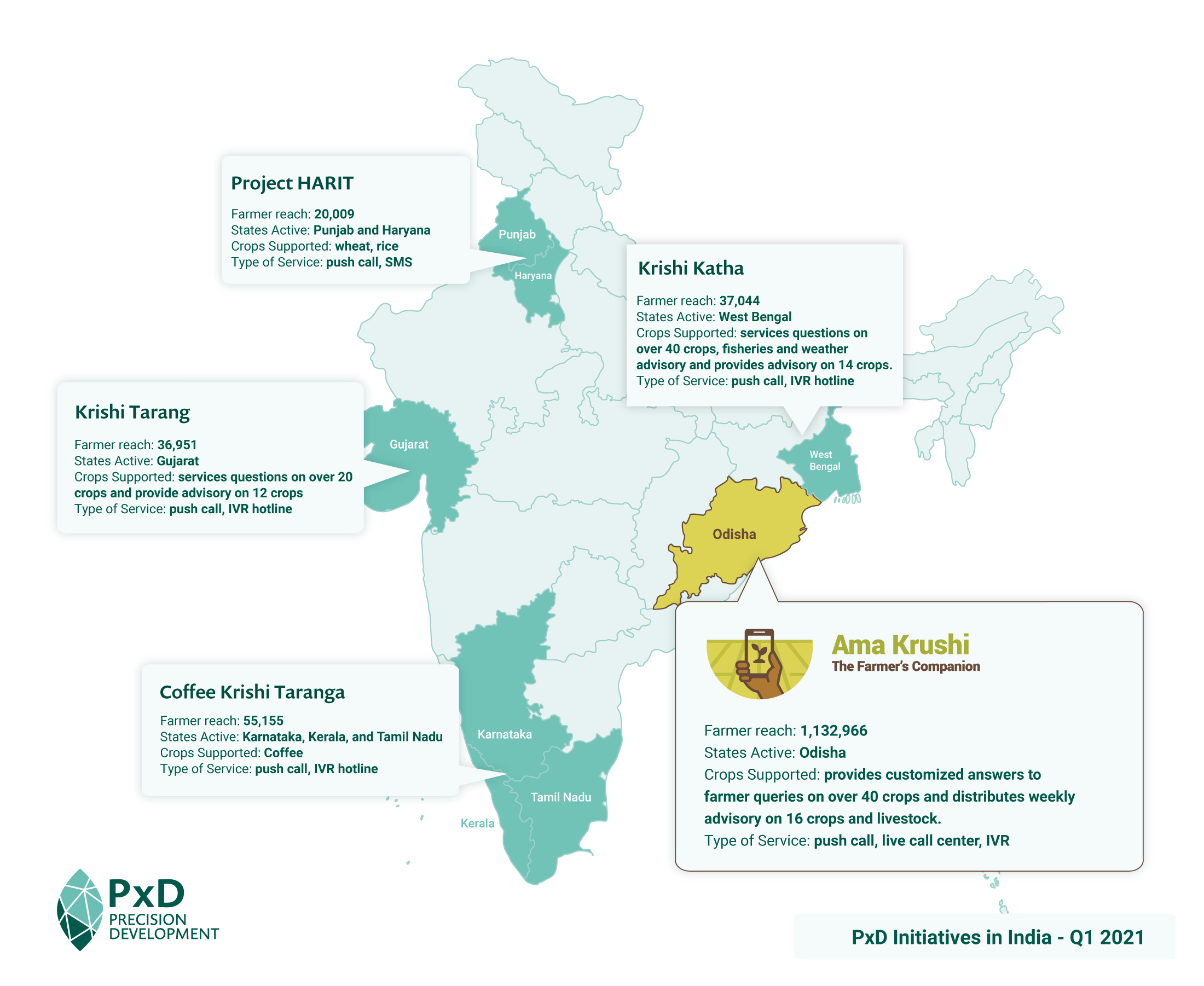
Agronomy
At PxD, the core of our work is to provide actionable information to people who need it, when they need it. All of our current services in India provide agricultural information to farmers timed to the crop cycle. Agricultural productivity can be significantly impacted by the timing and quality of critical decisions. As a consequence, the timing of information delivery is critical and is intended to maximize its value for farmers as they make key decisions and initiate activities in their fields.
In a typical year, South Asia’s monsoon season commences in the third or fourth week of June. At PxD, our teams in India have been hard at work preparing for the onset of the rains. In the second week of June, we commenced sending advisory information to over 1.4 million farmers, 1.3 of whom are served by our Ama Krushi service in Odisha. We will provide farmers with information on nineteen different crops.
In the monsoon-drenched east of the country, “paddy” (what people in the region call rice) is king, both in terms of the number of farmers who plant it and as a critical source of nourishment. In Odisha, 97 percent of farmers on the Ama Krushi service, plant rice during the Kharif season.
In the first weeks of June, our agronomy teams prepare paddy pre-planting and seed selection advisory to be sent to farmers ahead of the first rains. This information is intended to help farmers make more informed decisions and actions about purchasing inputs, the preparation of soils, and planning planting schedules. Pre-planting advisory is followed by advice on optimal planting practices, nursery management, fertilizer management, and pests and disease management.
As the Kharif growing season begins to wane in November, the team will commence pushing advice to farmers about when and how to harvesting non-paddy crops, and other post-harvest topics, such as best practices for storage and information about market prices. Rice stays in the field longer than most Kharif crops; in a typical year, the Odisha paddy harvest commences in December and can last well into January.
Tarun Pokiya, PxD India’s Lead Agronomist, explains the day-to-day work of the agronomy team and its importance:
At the peak of the Kharif season, our Ama Krushi team may broadcast up to 24 different messages in a week, depending on customization permutations. Kharif is by far and away the most important growing season for our farmers. While all farmers grow Kharif crops, only about 60 percent of Odishan farmers grow crops during Rabi, the sub-continent’s winter growing season. This is in part because most Rabi crops are irrigation-dependent, and many poor farmers have no access to irrigation infrastructure and equipment. The weather is also far more predictable. In the Rabi cropping cycle, the weather varies only a little year on year. By contrast, cyclones and other extreme events can wreak havoc on Kharif farmers, and the onset of the rains varies wildly by year and location. Kharif is a much more technical and complex planting season, and our farmers stand to gain much more from well-timed information, customized to their location and conditions.
Customization
A key advantage of digital extension is the ability to customize content to make it more relevant to individual farmer’s conditions, choices, and needs.
In Odisha, farmer users of the Ama Krushi service receive information customized according to the following dimensions:
- Location (by district) – the onset of monsoon can be very different in the west compared to the coastal belt, and crop calendars are customized accordingly; customization is also calibrated according to current weather conditions throughout the growing season.
- Dialect preference – Sambalpuri and Oriya
- Crops planted – paddy, blackgram, greengram, cotton, bitter gourd, bottle gourd, cabbage, cauliflower, groundnut, maize, pointed gourd, redgram, ridge gourd, brinjal, tomato, okra, and sugarcane.
- Paddy farmers receive further customization based on the type of land they work – low, medium or upland – which significantly impacts seed choice and growing conditions
- Irrigation status – has irrigation/does not have
Content preparation and process
PxD’s team of eight agronomists, one livelihood expert, and one fisheries expert, engages in systematic preparation ahead of each planting season. Given Kharif’s disproportionate importance, and the complexity of interwoven and potentially countervailing factors, the teams commence planning months in advance of the first message being sent to farmers.
- Our agronomists initially engage in an overall season scoping activity: prioritizing crops, laying out provisional timing for advisory content based on crop cycles, etc.
- Following the initial process, the teams prepare formal crop calendars for each crop supported. They layout parameters for the commencement and conclusion of cropping cycles, identify and prioritize topics and critical behaviors for promotion, etc.
- Thereafter agronomists are assigned crops and topics and begin drafting advisory content focussing on a package of practices for each crop.
- The team then assigns weekly advisory topics for drafting – agronomists prepare draft scripts in English based on the crop calendar and plan.
- The draft advisory is then submitted to a content review committee (local experts and officials) for approval.
- Following approval of the script in English, it is translated into the local dialect.
- Priority messages are field-tested to improve relevance and impact (see the section below)
- Voice messages are then recorded. A senior agronomist will then check the recording to ensure that the quality of the audio and translation is sufficient for broadcast.
- Messages are checked one last time by the Content team lead before they are uploaded to the system for broadcast.
Steps 4 through 8 are conducted on a rolling basis, whereby the content for the second week of June is prepared in the first week of June; for the third week in the second etc. This allows us to adjust the cycle of content as the weather shifts, and accommodate urgent advisory messages, for example in response to extreme weather events, or pest infestations.
Our teams are in constant communication via WhatsApp and a rotation of organizational meetings. We have to keep a constant eye on the weather and other conditions.
Cyclone advisory to farmers in Odisha ahead of Cyclone Amphan (May 2020)
Namaskar. Welcome to Ama Krushi, the free Agriculture Information Service of the Department of Agriculture, Government of Odisha. Some specific information for the farmer: Most of Odisha is likely to receive light to moderate rainfall over the next 24 hours due to the cyclone system and the resulting low pressure in the southeast of the Bay of Bengal and along the Andaman coast. This system is likely to gradually condense and take the form of cyclone. As a result, coastal districts are likely to receive moderate to heavy rains and strong winds. Following the rain, remove all excess water from your fields: paddy [rice], sesamum, jute, brinjal, chili, okra, gourds, and flowering crops. Cut paddy seedlings that are ready to be harvested and store them in a safe place. In your vegetable fields following the rain, stop any irrigation and refrain from applying insecticides. If mango, banana, and papaya are ripe, harvest them before the wind blows them from your trees. If cashew nuts ready for harvesting, pick the nuts and let them dry. Put in storage sufficient dry food and water for your livestock. Please contact Ama Krushi’s free hotline 155 333 for more information. Thank You.
Prasanna Kumar, PxD’s Senior Software Engineer, explains how we program calls and push calls through Paddy, our in-house technology stack (not the crop!).
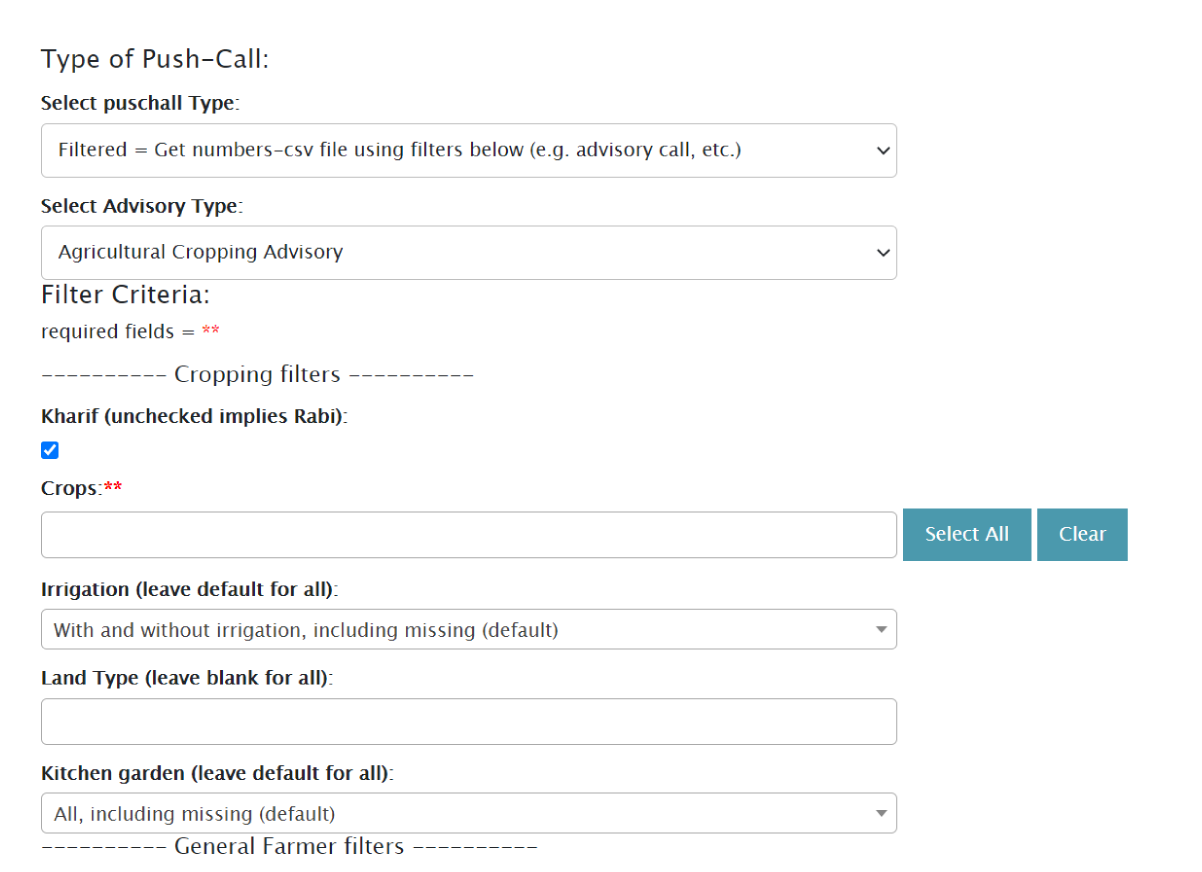
Our tech platform – Paddy – incorporates a high degree of automation and can run on a variety of backends, such as SMS platforms, IVR platforms, or chatbots on WhatsApp or Telegram. Our Ama Krushi, kharif platform is a Push Call platform.
Scheduling push calls can be complex in a project of the scale of Ama Krushi. As detailed above, our agronomist team sends out crop-specific, season-specific, and livestock-specific messages to farmers. To maximize their relevance to farmers’ needs, messages must take into consideration a farmers’ geography (district), topology (high land, low-lying land), the availability of irrigation, and – in some cases – the gender of the farmer receiving information.
To make the job easier for agronomists, we provide a Graphical User Interface (GUI) to schedule push calls. The GUI allows agronomists to apply filtering criteria (such as crops, season, irrigation, gender, district, etc.) which are then applied to each message. The message is then programmed to correspond to all the corresponding profiles in the database and returns only those profiles that satisfy all the filters.
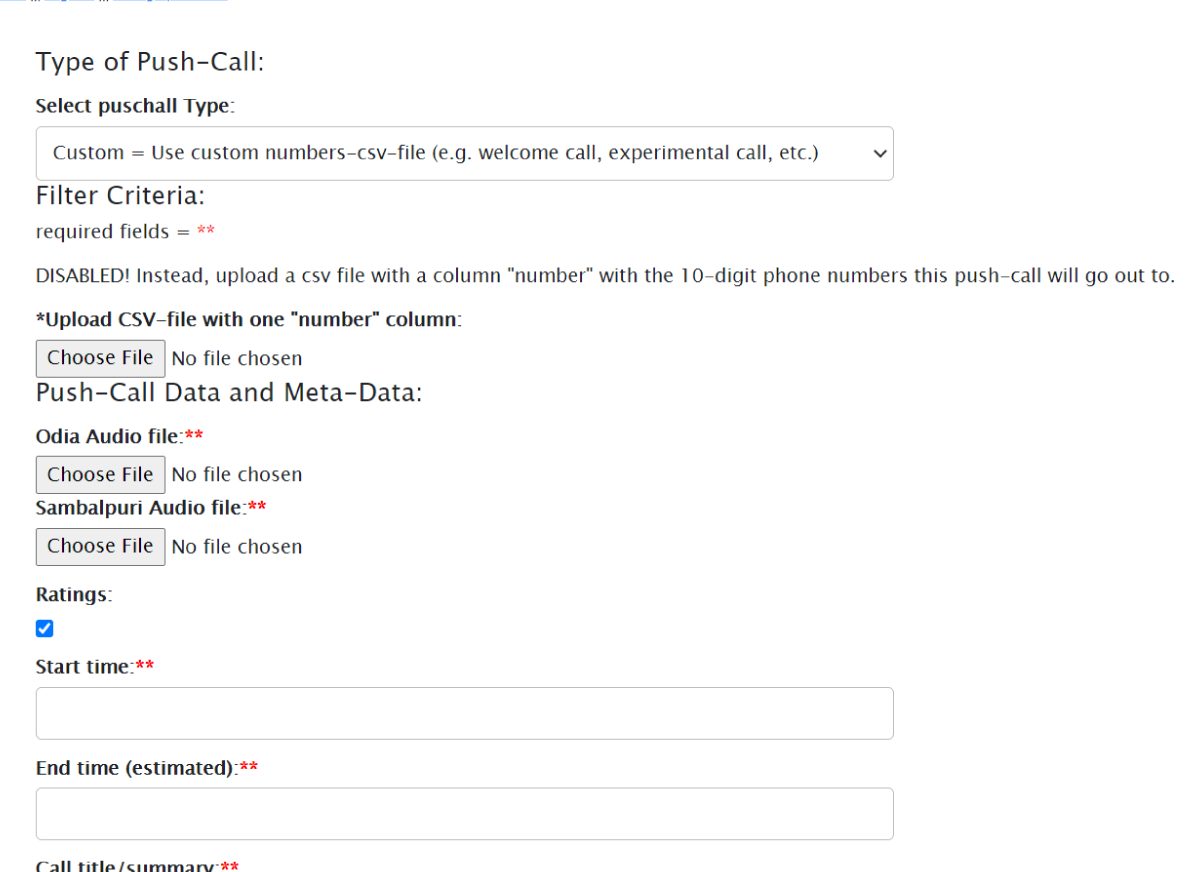
Our Graphical User Interface is designed to make it easy for our agronomists to apply filters and program calls
The agronomist then uploads the message audio to be sent. Our platform supports sending messages in different languages to farmers based on their stated language preferences. Hence, audio files for all supported languages have to be uploaded. Paddy (our backend system) then automatically assigns the language preference for a farmer from his profile and schedules the correct audio. The agronomist then picks the date and time at which the scheduled messages will start getting pushed. This completes the scheduling process.
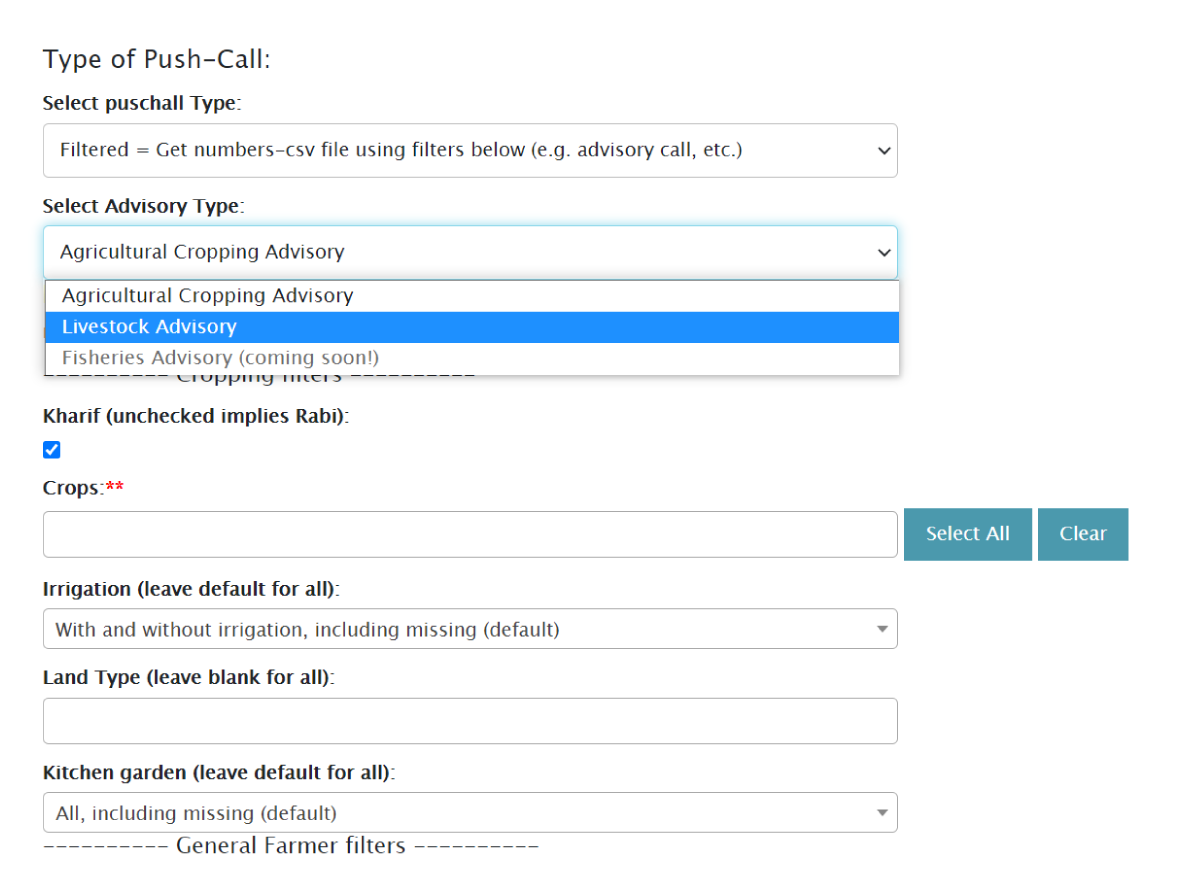
Our Ama Krushi push call service sends advisory on multiple topics, including cropping cycles, and livestock husbandry. We will be incorporating fisheries advisory shortly.
Our scheduling interface also allows for special cases. Here I will mention two:
Firstly, we need to schedule calls for farmers who may not have been fully profiled yet and for whom we have insufficient information in the database. The system allows for the uploading of phone numbers in comma-separated values (csv) format and then schedules messages to all the numbers in the list. Since these numbers are potentially un-profiled, no filters can be applied to them and a default language is assumed for all farmers (Odia in the case of Ama Krushi).
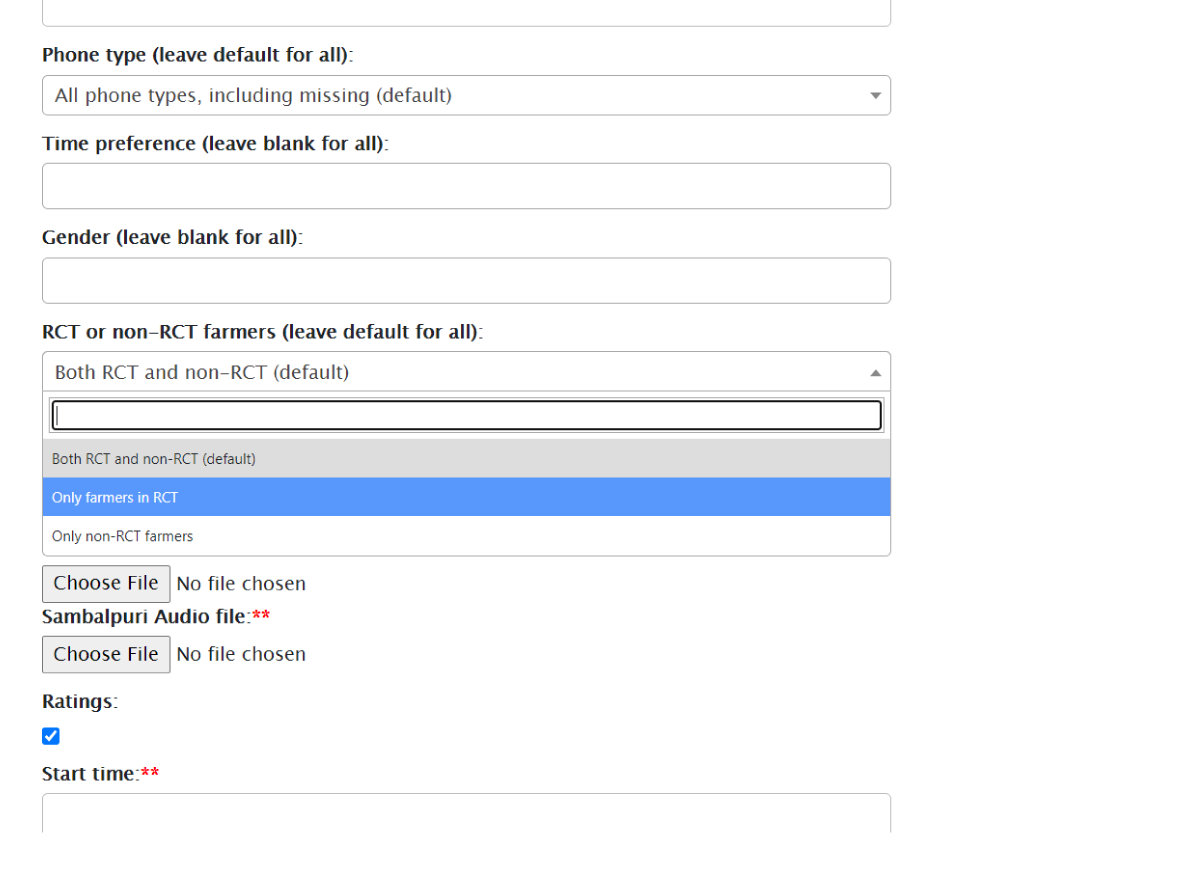
Paddy is designed to support and facilitate our research work. A/B testing. RCTs and other research experimentation can be facilitated, and filtered within the platform.
Secondly, to support A/B testing we provide a filter that ensures that farmers who are marked as “Control” or “Test” farmers do not receive the calls. Under special circumstances we allow this to be over-ridden and the same message will then be sent to all farmers (for example if we are warning farmers about an impending natural disaster, or COVID-related messages).
Hannah Timmis, PxD’s India Research Manager, and Tushar Singh, Research and Operations Associate, explain how we use field testing to drive product development, innovation and improved service delivery:
From resource constraints to limited access to capital and agricultural inputs, small-scale farmers in Odisha confront uniquely challenging barriers that limit their ability to close the yield gap. In this context, the objective of providing locally relevant and actionable information, customized to a farmer’s specific needs, is by no means simple.
To promote efficiency and the relevance of our content, we are piloting a two-step process for content design. This process aims to identify a long list of recommendations with the potential for high impacts on productivity and yields and frame these recommendations as messages that can be easily understood and acted on when they are communicated to farmers.
Step 1: Improve Content Prioritisation & Scheduling
Initially, while designing advisory content for the season, we identify and focus on farming practices that are low cost, low risk, and are evidenced to increase yield for small-scale farmers. We gather information from agricultural experts, our agronomist colleagues, and complementary literature, about the importance of key practices, expected yield increase, and information about complementarities across practices. To understand better what set of behavior changes and practices we can meaningfully influence, we use farmer data to estimate baseline adoption of targeted agricultural practices, farmers’ knowledge of these practices, perceptions of costs and actual costs.
For more complex farming practices, we collect more detailed data and insights to fill potential blind spots about farmer practices and perceptions, generate new, or different, hypotheses, and identify potential constraints to adoption. We also collect information to estimate the lead time farmers require to adopt new or amended practices. We ask farmers when they make their most relevant decisions and critical investments, and assess the extent to which changing behaviors would incur a time cost (e.g. travel time, procurement time, etc.).
Step 2: Improve Content Communication
When an advisory message is too long or too detailed, farmers may not have the time or bandwidth to process all the information. Delivering a compelling message helps to grab and maintain the attention of farmers, and helps to ensure that farmers connect with and internalize the information conveyed. Once we have identified priority content that can help farmers stabilize, or increase their production, we draft outbound messages using a message development template to increase the consistency and clarity of the framing. This template is one of the tools that help our team think about message design in a more structured way:
| # | Message Component | Maximum Length | Rubric | Notes |
|---|---|---|---|---|
| 1 | Welcome | sentence | Who is this message from? | Greeting and clearly identifying the sender of the call. E.g. “Namaskar, welcome to ‘Ama Krushi’, the Government of Odisha’s free agriculture information service.” |
| 2 | Topic | 1-2 sentences | What is this message about? | State advisory topic and briefly state concrete recommendation. E.g. “Today, we would like to tell you about an important practice called “seed treatment”, which means mixing your seeds with fungicide before planting. It is an essential precautionary measure to manage pests and diseases in crops. ” |
| 3 | Recommendation (Less technical) | 1-2 sentences | How should I act in response to this message? | A clear and if possible non-technical statement of the key recommendation. Ideally, there should be one recommendation per message. E.g. “In today’s advice, we recommend using either Carbendazim or Carboxin + Thiram to treat seeds before sowing. These seed treatment products are low-cost and widely available. ” |
| 4 | Rationale | Max. 3 sentences | Why should I change what I’m doing? | A brief explanation of the rationale behind the recommendation. E.g. “They protect crops from seed and soil-borne diseases and also help to produce healthy seedlings.” |
| 5 | Recommendation (More technical) | Max. 3 sentences | How should I act in response to this message? | A clear and more detailed technical statement of the key recommendation. E.g. “Seed treatment can be done in many ways, but here we will suggest two. You can use one or another. The first way is by mixing 2 grams of Carbendazim, also sold as Bavistin or Dhanustin, in every kilogram of seeds. The second way is by mixing 3 grams of Carboxin + Thiram, also sold as Vitavax power or Vaccinator power, in every kilogram of seeds.” |
| 8 | Thanks & followup | Max. 1 sentence | How to follow up for more information? | “Thank you, and remember that if you have questions about this advisory or need more information, you can call the Ama Krushi hotline on 155333” |
The template is intended to help us condense our main recommendations, emphasize their most essential components, and cohere message design.
If, for example, we find that farmers misperceive the efficacy or cost of a practice, we can emphasize the yield benefits and resource requirements in the recommendation rationale. When baseline knowledge and adoption are low, or the advice includes complex terms, we may determine that recommendations require additional reinforcement. In such cases, we can develop nudges and reminder messages focusing on critical aspects of the recommendation.
Lastly, the template helps us to document the evidence we use to generate our advice, thus improving the “evidence-based” nature of the content we develop. In addition to using the message template, we leverage behavioral insights and use framing tips and techniques to deliver the value proposition optimally. To ensure there are no discrepancies between the English and Odia versions of the message, another Odia-speaking member of the team will review translations and audio recordings before the dissemination of the message.
In the final section of this blog post, Srinivas VT, Research and Operations Associate, and Revati Vaidya, Process and Product Innovation Associate, provide an overview of our recently developed dashboard which allows for more effective and precise monitoring of program performance.
The objective of our dashboard is to provide a real-time view of program performance through Key Performance Indicators (KPIs) that:
- Minimize the need for longer data extraction processes;
- Allow us to quickly view the health of the program and identify issues via available trendlines; and
- Provide visual representation of data to put things in perspective.
Before we developed the dashboard, we needed to run long queries on pgAdmin to extract metrics. Now, we can select our parameters, press “compute”, and the dashboard pulls from the backend data tables which give us the metrics we need in an easy-to-read format. These dashboards have been developed using an R-shiny web application.
The Odisha dashboard is split into six operational sections. Data in each section can be filtered according to time and other parameters relevant to the section. For farmer data, for example, this includes demographic filtering (gender, district, smartphone ownership, etc.).
- Call Activity: Provides a quick view of the number of outbound calls that have gone out recently to farmers.
- Helpdesk: Contains the complete list of the questions that farmers have asked via the hotline. Recordings of the question/responses are embedded into the helpdesk tab so that we can listen to the recordings by pressing a play button.
- Profiles: Overview of Ama Krushi farmers, total registered, their demographic distribution, etc.
- Call Centre: Details on Call Centre productivity that include profiling rate, conversion rates, hourly productivity, etc.
- QnA Backchecks: A tab where the team can generate and listen to a random sample of Farmer Questions and Answers provided by the content team for quality checks (i.e to ensure proper tagging has been done, no valid calls have been rejected, etc.)
- Usage Data: This section is where ‘the meat’ of data on farmer engagement lies. This is, in turn, bucketed into three sub-sections:
- Outgoing: This sub-section allows us to look at farmer engagement with our outbound calls – primarily how many farmers pick up our calls, how long they listen, etc. The screenshot below, depicts metrics for outgoing calls over the last six months:
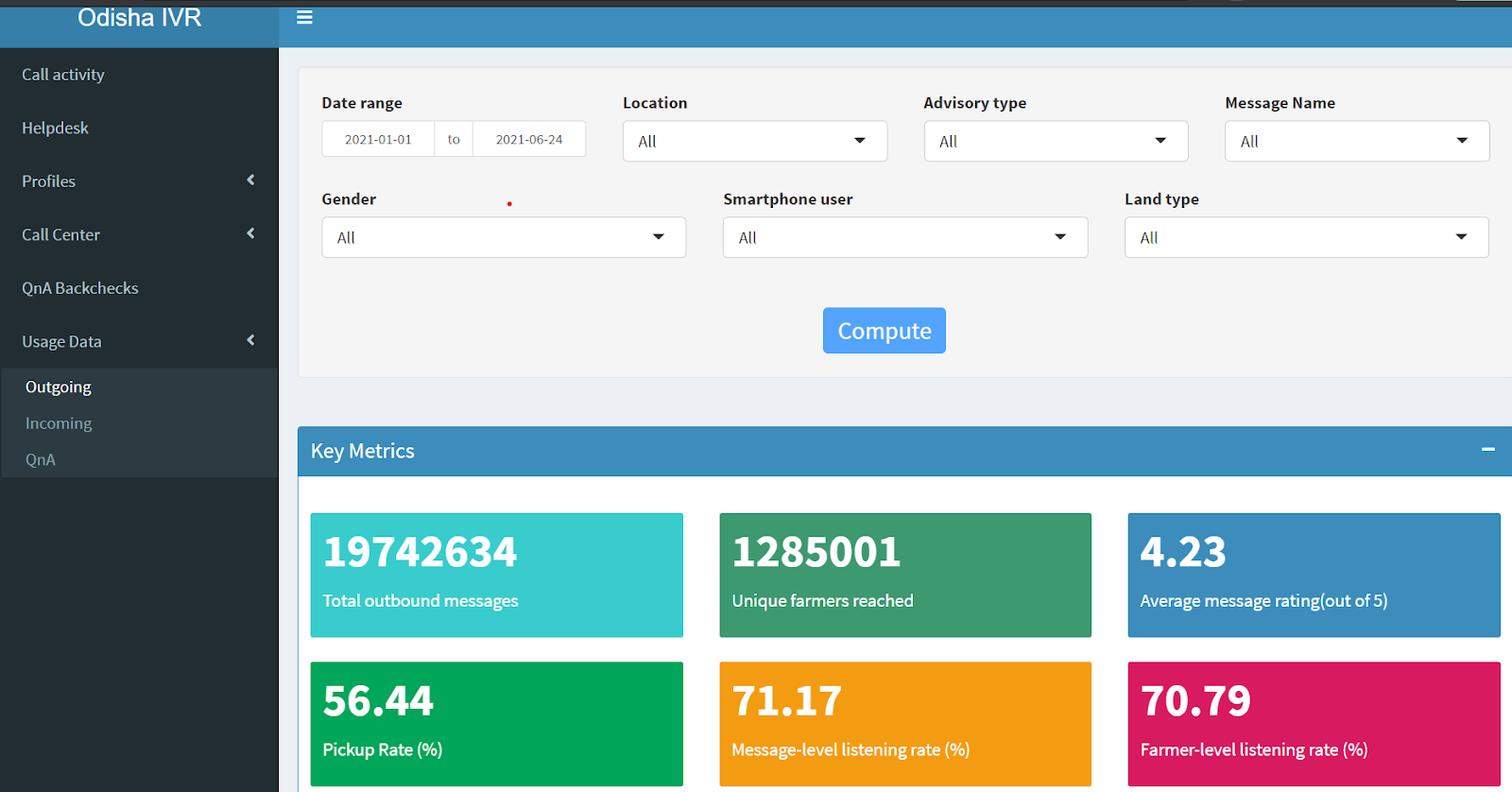
- Incoming: The sub-section provides us with details on (i) inbound engagement (how many farmers are calling in, how many of them are registered, how long they spend on the call, etc.) and (ii) what farmers do when they call in – i.e what part of the menu they go to. The screenshot below depicts inbound metrics for non-smartphone owning women farmers over the last six months:
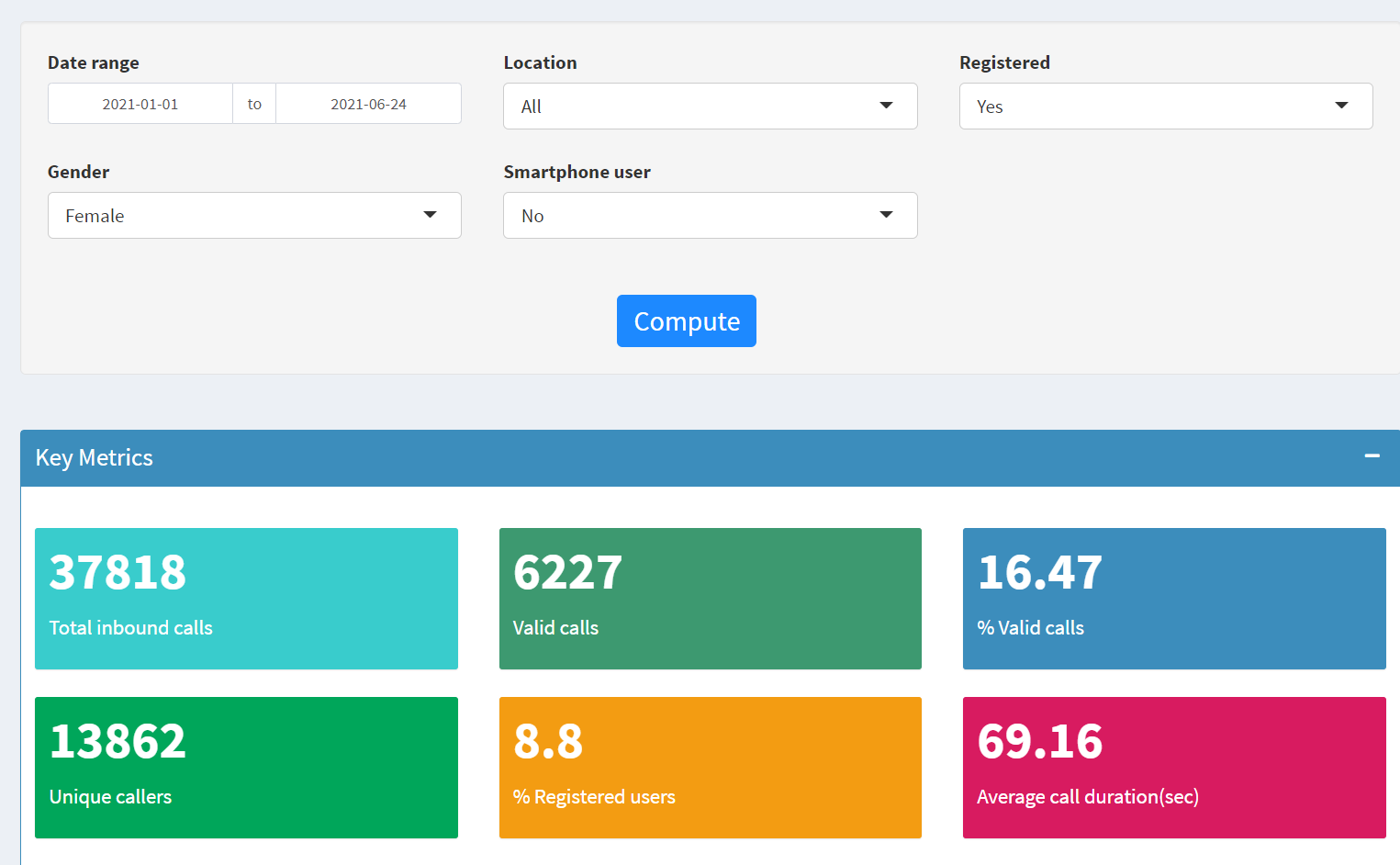
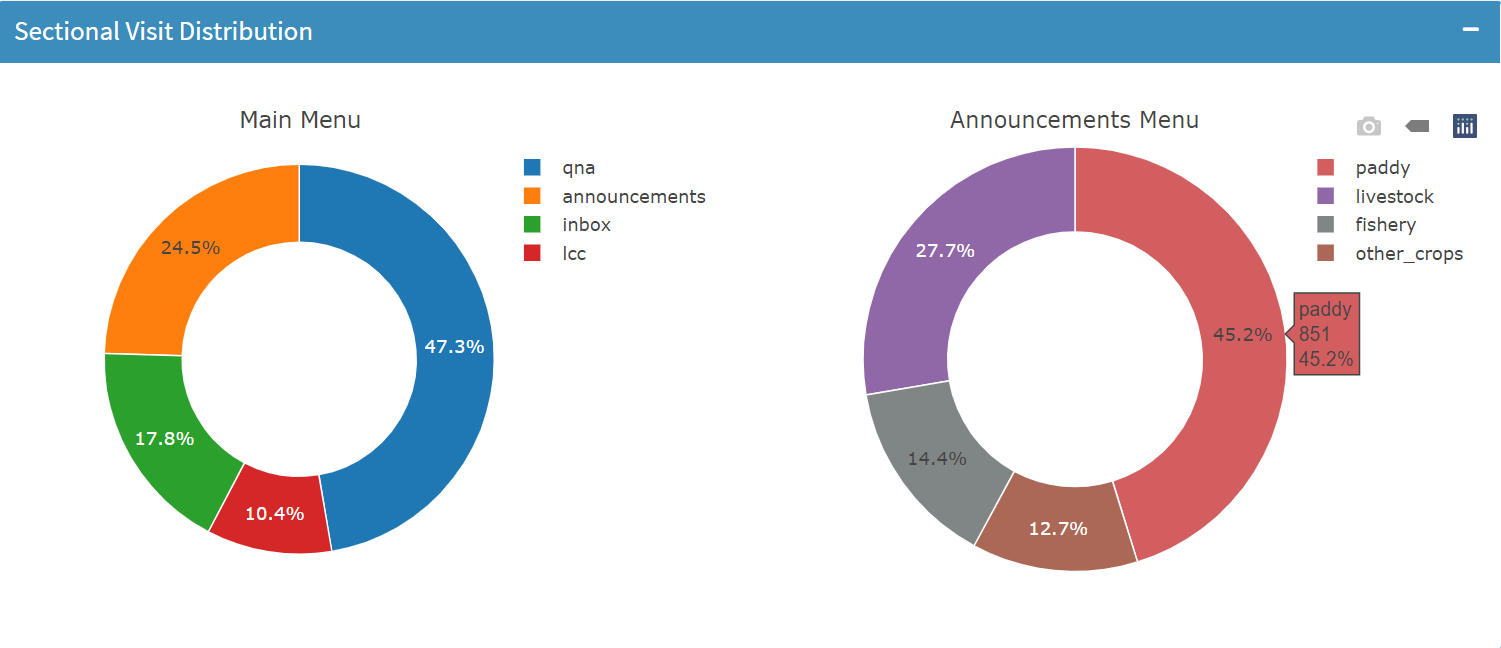
- Q&A: This sub-section specifically focuses on farmer questions allowing us to see:
- Key metrics looking at basic numbers (how many we are receiving, how many and how quickly we are responding to them); and
- Details on the types of questions (determined by how they are tagged).
The screenshot below presents data on farmers that have asked questions relating to crop-based advisory over the last six months:
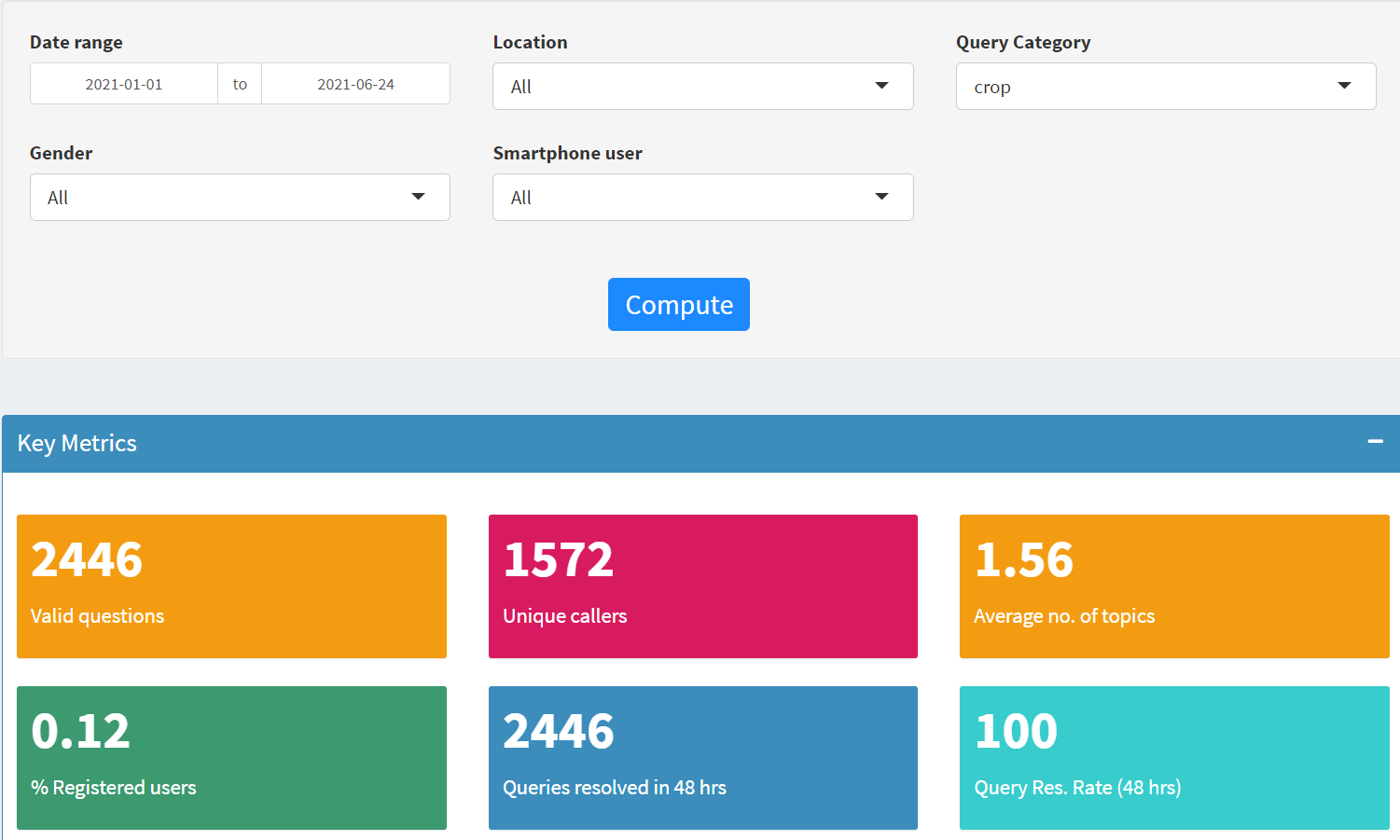
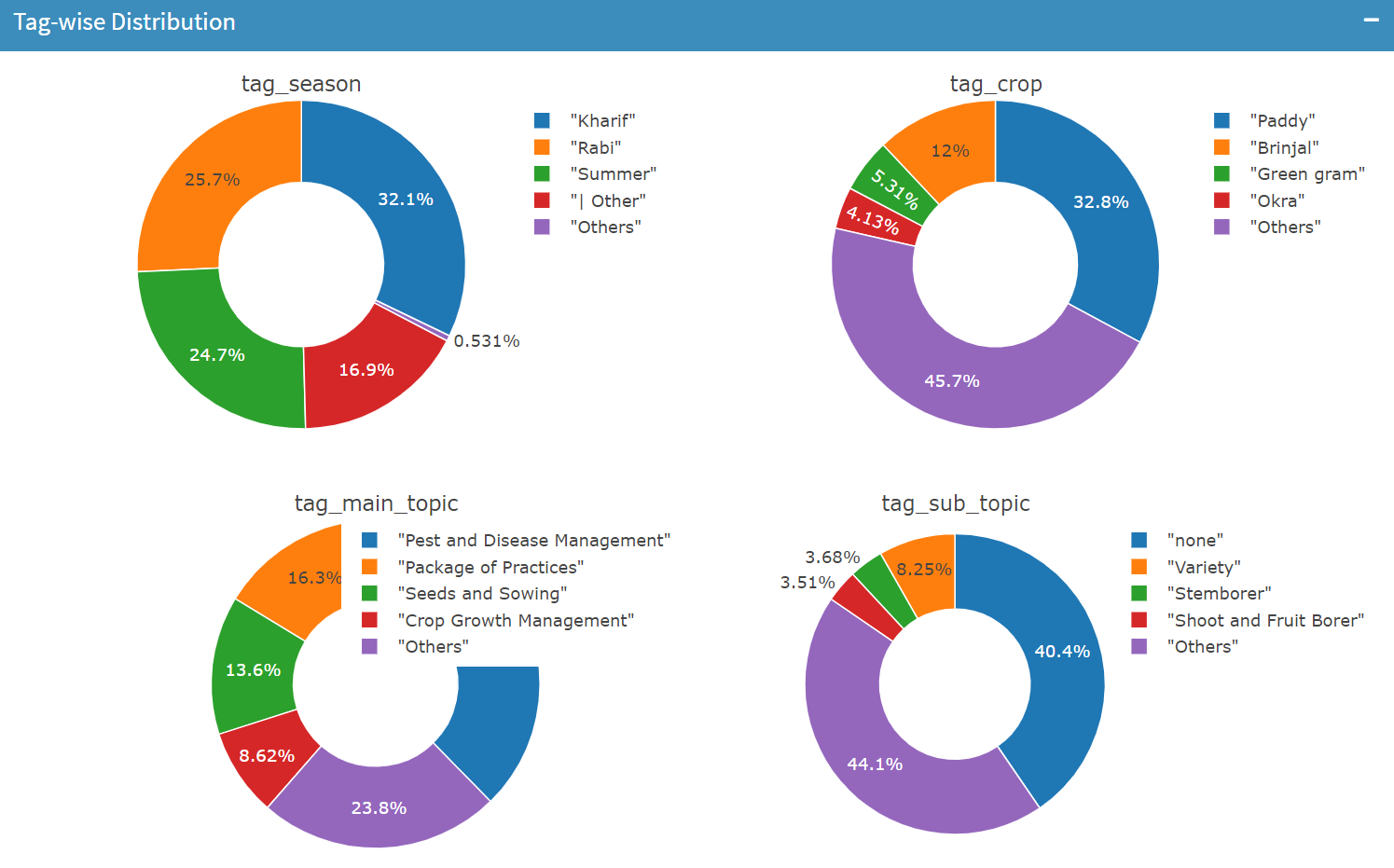
All backend data has now been linked to our Odisha dashboard (a West Bengal dashboard is also up and running and undergoing further development!). As more teams begin using the dashboards regularly, we want to make sure that the experience is as seamless as possible. We plan additional UI/UX improvements in the coming weeks to optimize user experience and ensure the dashboard is doing what it is designed to do – giving us the data we need with ease, speed, and accuracy (and some fun aesthetic!). We eventually want to replicate the improved template across all project locations to create a centralized PxD`India dashboard.
As our teams and farmers navigate July’s unpredictable weather, the workstreams above are complemented by – and work in concert with – carefully calibrated and informed actions on the part of colleagues at our (remote) call centers, our government partners, and traditional extension agents. We hope that the synthesis of our activities and actions will support our farmers to make more informed and more productive decisions as they navigate a fruitful and bountiful Kharif season.
For more information about our work, or to explore potential partnerships, contact communications@precisionag.org

Crystal Aghadi, Research Associate, John Babadara, Program Associate, and Godfrey Petgrave, Agronomist, report on PxD Nigeria’s most ambitious challenge yet: delivering advisory information to over 100,000 Nigerian smallholder farmers.
Team PxD Nigeria is in the process of unleashing a wave of scientifically validated agricultural information to support the productivity of over 100,000 smallholder farmers during Nigeria’s 2021 Wet Season. Information to promote optimal cultivation and input use in support of nine priority crops is being delivered via automated push calls directly to the mobile phones of farmers across eleven Nigerian states, including Nigeria’s poorest, and conflict-affected states in the Northeast and Northwest Regions of the country. The Wet Season is particularly important for poorer farmers who rely on rainfed agriculture and is the most intensive and productive cultivation period of the year.
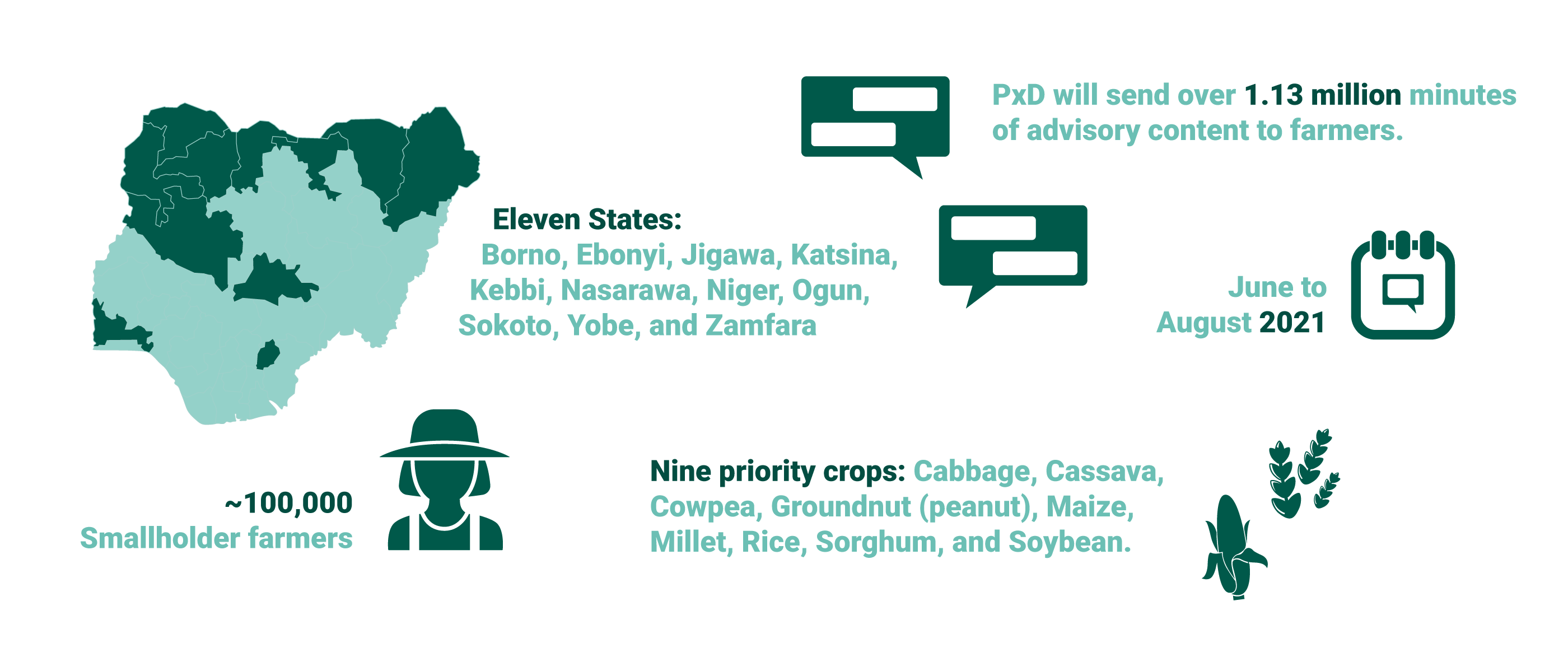
The messages that Team PxD Nigeria is delivering have been designed to maximize accessibility and relevance to smallholder farmers’ needs with the intention of buttressing and improving agricultural productivity and incomes at a time of heightened need. The message delivery schedule is aligned to critical decision points in the agricultural calendar so that farmers receive information when it is most practical and actionable for them. Our advisory content, and the timing of its delivery, are designed to assist users to make more informed and productive decisions during pre-planting, cultivation, and the harvest and post-harvest periods.
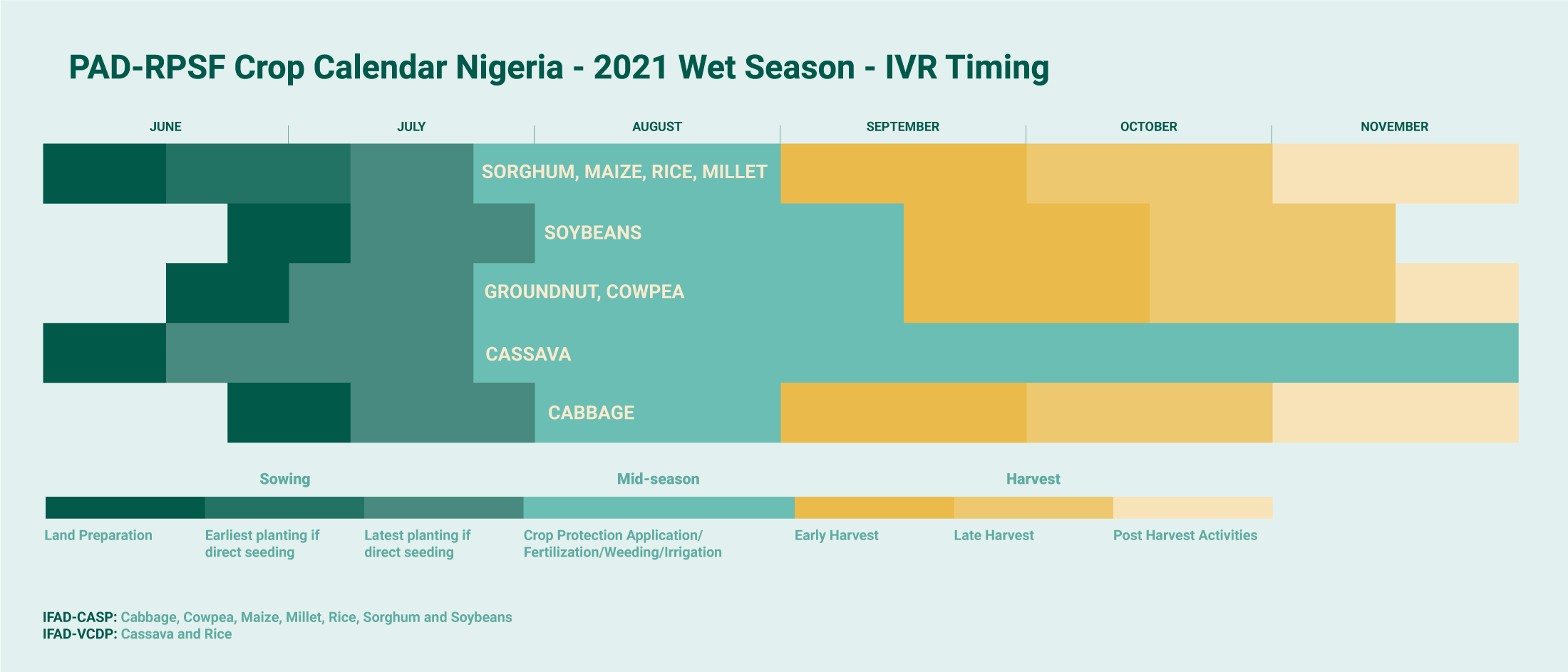
Our Partners
On 12 November 2020 the Nigerian Federal Ministry of Agriculture and Rural Development (FMARD), the International Fund for Agricultural Development (IFAD), and PxD announced the inception of the Nigeria Rural Poor Stimulus Facility (NRPSF).
The Nigeria RPSF is designed to mitigate the impact of COVID-19 on smallholder farmers and to insulate domestic food supply by supporting access to affordable inputs and advisory to sustain production. The NRPSF is funded by, and aligned with, IFAD’s overarching Rural Poor Stimulus Facility which was established in 2020 to improve the resilience of rural livelihoods in the context of the COVID crisis by ensuring timely access to inputs, information, markets, and liquidity. The initiative is being implemented under the auspices of the Climate Change Adaptation and Agribusiness Support Programme (CASP), a comprehensive action plan being implemented by FMARD with support from IFAD.
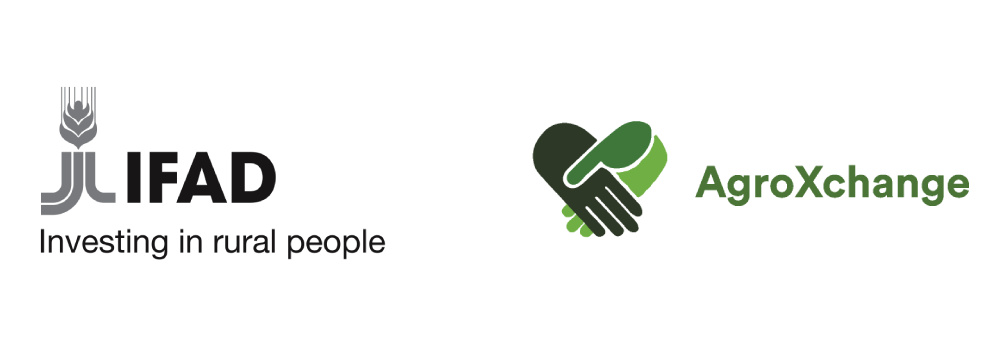

PxD is working with IFAD and the Government of Nigeria’s CASP initiative to build and scale mobile phone-based agricultural extension to support smallholder farmers in the seven Northern Nigerian states of Borno, Jigawa, Katsina, Kebbi, Sokoto, Yobe, and Zamfara, as well as Ebonyi (Southeast), Nasarawa and Niger (Central), and Ogun (Southwest). To reach more users and maximize the impact of the grant, PxD is collaborating with additional actors and initiatives driving innovation in the Nigerian agriculture sector, including: the IFAD-supported Value Chain Development Program (VCDP) which uses a demand-driven approach to develop markets, address constraints and increase market access for smallholder farmers and medium-scale agro-processors along Nigeria’s cassava and rice value chains. PxD is also working with AgroXchange Technology, a private technology firm with on-the-ground access to farmers, that uses a digital profiling platform to facilitate access to markets, credit and inputs on the part of Nigerian farmers. We are also working to deepen the reach and access a new group of smallholders recruited by Pacific Ring (Cassanovas), a private firm working to expand production and post-production opportunities for cassava farmers in collaboration with the Nasarawa State Ministry of Agriculture.
Operational Context
Even before COVID-19’s ill winds began to buffet the global economy, Nigeria’s economic performance confronted significant headwinds linked to lower oil and commodity prices. In the near term, the World Bank expects unemployment and underemployment to increase, with disproportionately negative implications for the poor.
The Wet Season advisory campaign will empower smallholder farmers in Borno, Jigawa, Katsina, Kebbi, Sokoto, Yobe, and Zamfara States – across Nigeria’s Northeast and Northwest Regions – where poor human security has compounded legacy developmental challenges with negative implications for smallholder livelihoods and food security. The farmers who will receive information from PxD in the seven states that span Nigeria’s northern border are beneficiaries of IFAD’s CASP initiative. The 2021 Wet Season advisory campaign will also deliver advisory information to smallholder farmers in Ebonyi, Nasarawa, Niger, and Ogun states. Farmers in these additional four geographies are representative of other regions – the Southeast, North central and Southwest of the country, respectively. It is hoped that their inclusion will serve as further proof of concept for the integration of digital extension services in Nigeria, country-wide and at scale. The addition of farmers from Ebonyi, Nasarawa, Niger and Ogun states was made possible through a strategic collaboration with the IFAD supported Value Chain Development Program (VCDP), and collaboration with private sector partners actively implementing programs to support smallholder farmers.
A significant challenge in fragile and conflict-affected areas is balancing the need for extension services with multi-dimensional risks. Insecurity in Northern Nigeria has negatively impacted farming. When overlaid with the preexisting high levels of poverty in the region, conflict-affected and constrained supply chains, market disruptions, damaged infrastructure, and human displacement are contributing to an escalating food crisis for many communities. PxD’s digital extension services can be provided to farmers without the need for in-person contact, a significant advantage in conflict-affected areas, and with regard to ongoing physical distancing protocols necessitated by the ongoing COVID-19 pandemic.
Need throughout the region is expected to be particularly pressing this year as the onset of the main rainy season has been delayed. The Nigeria Meteorological Agency (NiMET) forecast predicts a combination of delayed rains, fewer days of rain, and a longer than usual dry spell, particularly in the Northern region where our service is concentrated.
Between January and March 2021, PxD Nigeria implemented our inaugural digital extension service which broadcast Dry Season advisory to a cohort of 5,613 smallholder farmers to support the cultivation of five priority crops. In April 2021, after the completion of the Dry Season campaign, the team conducted a survey of farmers to assess the efficacy of the service and inform future programming. Prominent among the information received from farmers was that only 26 percent of farmers surveyed reported access to any other form of extension service. The dearth of alternative and accessible sources of trustworthy agricultural information underscores the utility of digital extension in remote- and conflict-affected areas, and additional challenges that confront in-person extension services in the context of a pandemic.
How the System Works
PxD’s advisory information is delivered via push calls coordinated through a Paddy-powered voice-based platform and focuses on increasing smallholder farmer knowledge about affordable inputs and promoting activities that improve productivity and income generation.
Paddy is what we call our backend technology – the framework we use for building two-way communication applications to communicate with our users on their mobile phones. Paddy’s versatility allows for a great deal of automation, provides comprehensive monitoring tools, and enables our team to run tests and tweak the platform in real-time as we concurrently deliver our advisory service.
Advisory calls are timed so that the first attempt to place a call to each farmer is at 7AM. If a farmer does not pick up the initial call, three retries will be attempted at the same time on the subsequent three days. The timing of calls is informed by PxD’s experience delivering an initial service to 5,613 farmers during the Dry Season, and a follow-up survey with users of that service. The call times explicitly avoid times when farmers may be observing religious practices.
e-Extension in Practice
A total of 85 push call messages have been developed to support the cultivation of nine priority crops during the Wet Season (10x Millet-related messages, 9x Soyabean, 9x Cowpea, 10x Cassava, 10x Sorghum, 9x Cabbage, 8x Groundnut, 10x Maize, and 10x Rice). Message content addresses key practices farmers can adopt to improve their productivity and yields.
The team has developed approximately two hours of content to be pushed via voice calls to farmers to support the cultivation of nine crops. Extrapolating from the average pickup and listening rates we observed during the Dry Season campaign, we hope that farmers will access between 600,000 and 900,000 total minutes of content depending on pickup and listening rates.
Each message is translated and recorded in Hausa, Igbo, and Yoruba to accommodate users in Nigeria’s various regions. Messages are designed to be delivered in approximately two minutes or less to maximize information retention and mitigate the potential for distractions while listening. Messages prioritize information about the following Good Agronomic Practices (GAP):
- Soil requirements for selected crops
- Climatic requirements for selected crops
- Land preparation for selected crops
- Sowing/planting methods for selected crops
- Fertilizer Management
- Integrated Pest and Disease Management
- Disease management – Bacteria, Fungi, and Virus
- Key Pests and Diseases management for selected crops
- Good Harvest practices
- Good Post-harvest practices
Examples of calls to farmers.
Hausa Audio file of 1st Millet Call to Farmers (Women narrator):
English Translation: Do you know that millet does not grow well in flooded conditions? In preparation for the wet season, do not grow millet on soils prone to waterlogging and flooding. This is because doing so will cause shallow rooting, low seed protein, and poor yields. Millet can be grown on a wide variety of soils ranging from clay loams to deep sands. For better yields and grain quality, it is best to grow millet in deep, well-drained productive soil. Properly managed soil and good tillage practices will give millet deep rooting which will result in good seed production and higher yields for the farmer.
Igbo Audio file of 5th Cassava Call to Farmers (Women narrator):
English Translation: Applying fertilizer on your cassava farm should be based on results from soil analysis, but if the soil test is not done, you can then use the land history and vegetation as a guide. In the absence of any soil testing agents, you can also determine the quality of your soil by simply taking note of the weeds or other plants that are growing on the land before clearing. If you observe more broadleaf weeds on the land, this is a good sign that the soil is good. Another physical way to check for the quality of your soil is to check if it smells, a rich soil will smell like dirt while a bad soil will have no smell at all. For best yield, apply 3 – 4 bags NPK 15:15:15 on 1 acre of cassava farm. Apply Fertilizer at 8 weeks after planting. Apply 1 match box-full of NPK fertilizer around each stem, 10 cm from the plant, this is two fingers away from the stem, or broadcast with care around the plant, making sure the fertilizer does not touch the stem or leaves so that it doesn’t burn the plant.
Hausa Audio file of 5th Rice Call to Farmers (Man narrator):
English Translation: Preventing pests in your field will save money on pesticides and increase the value of your harvest. Intercropping beans with your rice can discourage pests from your field. Keeping your field clear of weeds, debris, and dead plants will also keep pests away.
Visit your field regularly and check at least 10 plants for signs of pests. If you notice signs of pests, speak to your agro dealer immediately for advice. Be careful– if chemical pesticides are used incorrectly or used too much, pest problems can become worse in the future.


Information poverty – when people do not have access to information about knowledge and technology to inform productive decisions – is a key driver of material poverty, and a significant challenge impeding poor people as they attempt to improve their lives.
Precision Agriculture for Development’s (PAD) work, at its core, was to scale cost-effective digital information provision via services that empower poor people with knowledge to improve their lives. We know that it is possible to provide targeted, customized, and actionable information very cheaply and directly to poor households. Our work demonstrates that our model is extremely cost-effective and that it is a scalable way of bringing benefits to the world’s poorest people. But we also know that smallholder farmers need more than agricultural information and that poor people beyond the remit of smallholder agriculture stand to benefit from our services.
As we have grown and demonstrated our impact and cost-effectiveness, we have fielded inquiries and pursued lines of inquiry that – were we to fulfill them – would stretch the credulity of a “digital agriculture service”. As the experience of piloting and operationalizing our ElimuLeo service bears out, our expertise, capabilities, and services are demonstrably transferable to an educational context. We believe there are other sectors in which we can add value too.
An additional challenge we as an organization have grappled with is that “Precision Agriculture for Development” does not accurately describe the work we do. In fact – as followers of precision agriculture will know – the name of our organization has implied that we do work which we do not do; and suggest sectoral guardrails that can inhibit our potential to expand and diversify our operations, partnerships, funding base, and potentially our human resource base.
Introducing Precision Development (PxD):
In light of these and other considerations, in August 2020, PAD’s Board authorised PAD to consider opportunities to provide information services in education and other sectors, in addition to agriculture. In September we formally changed our legally registered name to Precision Development (PxD) to accommodate a wider range of possible activities. Agriculture will remain our primary focus and smallholder farmers and their families will continue to constitute the vast majority of our users.
We are excited to present to you our new logo and branding assets. We hope you will join us as we consider new opportunities and partnerships, within and beyond agriculture, to advance information provision to poor families in developing countries. From a practical perspective, our acronym “PxD” will help to set us beyond the ranks of the many “PDs” crowding the acronym marketplace. We also hope that the “x” will invite conversation about what we do, our secret sauce, and the possibilities implicit in our services, experience, and capabilities.
As PxD iterates, learns and grows, we will remain committed to a few core principles:
- We will continue to serve the very poor.
- We will continue to work through the combination of rigorous research, learning and evidence-based iteration.
- We will maintain our focus on delivering actionable information and addressing frictions that inhibit productivity.
- We will work to deliver our services at scale, and at low marginal cost.
- We will partner flexibly and generously to advance these ends.
- We will continue to provide agricultural advice, given how important this is for many of the world’s poor.
If you would like any additional information about PxD or would like to explore a new collaboration, please do not hesitate to contact us.
X marks the spot!
Make an Impact Today

